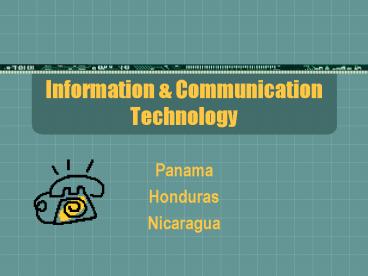Information - PowerPoint PPT Presentation
Title:
Information
Description:
Information & Communication Technology Panama Honduras Nicaragua Communication Statistics From The - CIA FACTBOOK Phone and Cell Phone Subscribers Source: Regulating ... – PowerPoint PPT presentation
Number of Views:35
Avg rating:3.0/5.0
Title: Information
1
Information Communication Technology
- Panama
- Honduras
- Nicaragua
2
Communication Statistics From The - CIA FACTBOOK
Panama Honduras Nicaragua
Telephones Main in use 396000 234000 140000
Telephones - Mobile 17000 14427 7911
TV Stations 38 11 3
Internet Country Code .pa .hn .ni
ISPS 6 8 3
Internet Users 45000 40000 20000
Internet Users as percentage of population 1.5 .5 .3
3
Phone and Cell Phone SubscribersSource
Regulating Entity of Panama Ente Regulador de
Panama
1998 1999 2000 2001 2002
Total Phone Lines 418756 462476 429135 376499 386904
Phones Lines per 100 15.1 16.4 15.1 12.6 13.6
Total Cell Phone Subscribers 85833 232888 410401 495396 569705
Cell Phones per 100 3.1 8.1 14.5 17.5 19.2
4
Telecommunications Information - Panama
- InfrastructureAccording to the CIA World Fact
Book, Panamá has well developed telecommunication
facilities, including domestic and international
facilities. According to the ARI (Inter-oceanic
Area Authority-Autoridad de la Región
Interoceánica), Panamá has access to one of the
best submarine optical fiber connection
infrastructures in Latin America. The ARI is an
organization that administrates and maintains the
areas that were reverted to the Panamanian
government in the year 2000, and its goal is to
promote the productive integration of these areas
in order to benefit the country. - Infrastructure at the National LevelOn the
national level, Panamá has four optical cable
systems which are extended throughout the
country. - Submarine Optical Fiber Connections
Internationally, it has the following submarine
optical fiber connections PAC system connects
Japan, California, Mexico, Panama, St. Croix,
United States and Europe.SAC system connects
Panama, Peru, Chile, Argentina, Brazil, Venezuela
and Colombia.Pan American system connects
Panama, Colombia, Peru, Ecuador and Chile.MAYA
1 connects Florida, Mexico, Guatemala, Costa
Rica, Panama, Colombia, Puerto Rico, Grand Cayman
and Jamaica.ARCOS connects Central America and
the Caribbean. - Brief History of Privatization and
De-Regulation1996 The Panamanian government
began the process of privatization of the
National Institute of Telecommunications
(INTEL-Instituto Nacional de Telecomunicaciones).
1997 The INTEL provided telecommunication
services until 1997. The companies that were
pre-qualified to buy the rights to 49 of the
INTEL were Cable and Wireless, GTE, and South
Western Bell. South Western Bell retired before
negotiations got underway, leaving Cable and
Wireless and GTE as contenders.1997 Cable and
Wireless bought 49. The government owns the
remaining 51. 2003 The telecommunications
market was opened and other companies were
allowed to enter the market. As a result, Cable
and Wireless ceased to have the monopoly in the
market, for national and international services.
Telecarrier Inc. and Clarocom are currently
providing competitive rates for national and
international calls. Companies seeking to enter
the market in the near future include Advanced
Communications, Galaxy Communications Corp.,
System One World, Tricom, and Voip Comunicaciones
de Panamá.
5
Honduras
- Public phone services are found throughout the
country. Either as coin public phones, phones
that can be used for a per minute price in hotels
or shops and Hondutel the national phone service
provider has offices throughout the country where
national and international calls can be made. Fax
services can also be found in most towns,
additionally so can Internet cafes. - Access to telecommunications services in Honduras
remains well below the Latin American average.
The installed telephone network capacity in
November 2001 is 415,131 lines, with 322,500
lines in service in 2002. Line penetration for
the entire country is 63, with 4.8 telephone
lines per one hundred inhabitants. - Privatization of the telecommunications sector
remains incomplete and the sale and reform of the
state telecommunications entity Hondutel has been
postponed. - The National Telecommunications Commission
(Conatel), an independent regulatory agency was
created for the telecommunications sector.
6
Internet in Honduras
- Basic Statistics 2000 (per 1000 inhabitants
except as noted) - Daily Newspapers 55
- Radios 412
- TV Sets 96
- Telephone Mainlines 46
- Cell Phone Subscribers 24
- Personal Computers per 1000 inhabitants
10.8 - Internet Hosts Registered Under Geographic Domain
157 - Adult Literacy Rate ( ages 15 and over)
75.1
7
ICT - Honduras
- International phone calls are astronomically
expensive from Hondutel - A three-minute call
- to the US or Canada currently costs US11.50
- to Europe US14.80 and
- to Australia or New Zealand US18.20
- The branches in Tegucigalpa and San Pedro Sula
are open 24 hours - elsewhere, offices are open daily from 7am to
9pm. - In all the main tourist destinations and most
cities there's now a cybercafé or communication
centre - Many cybercafés also offer Web phone calls, which
cut international call rates to the price of
surfing the Net - Police have periodically raided cybercafés and
confiscated Web phone equipment - Another alternative option is to purchase an
international calling card - There are also public phone booths scattered
around the major towns - Fax services are available in most Hondutel
branches - Note that there are no area phone codes
- Internet use has mushroomed in Honduras in the
last few years

